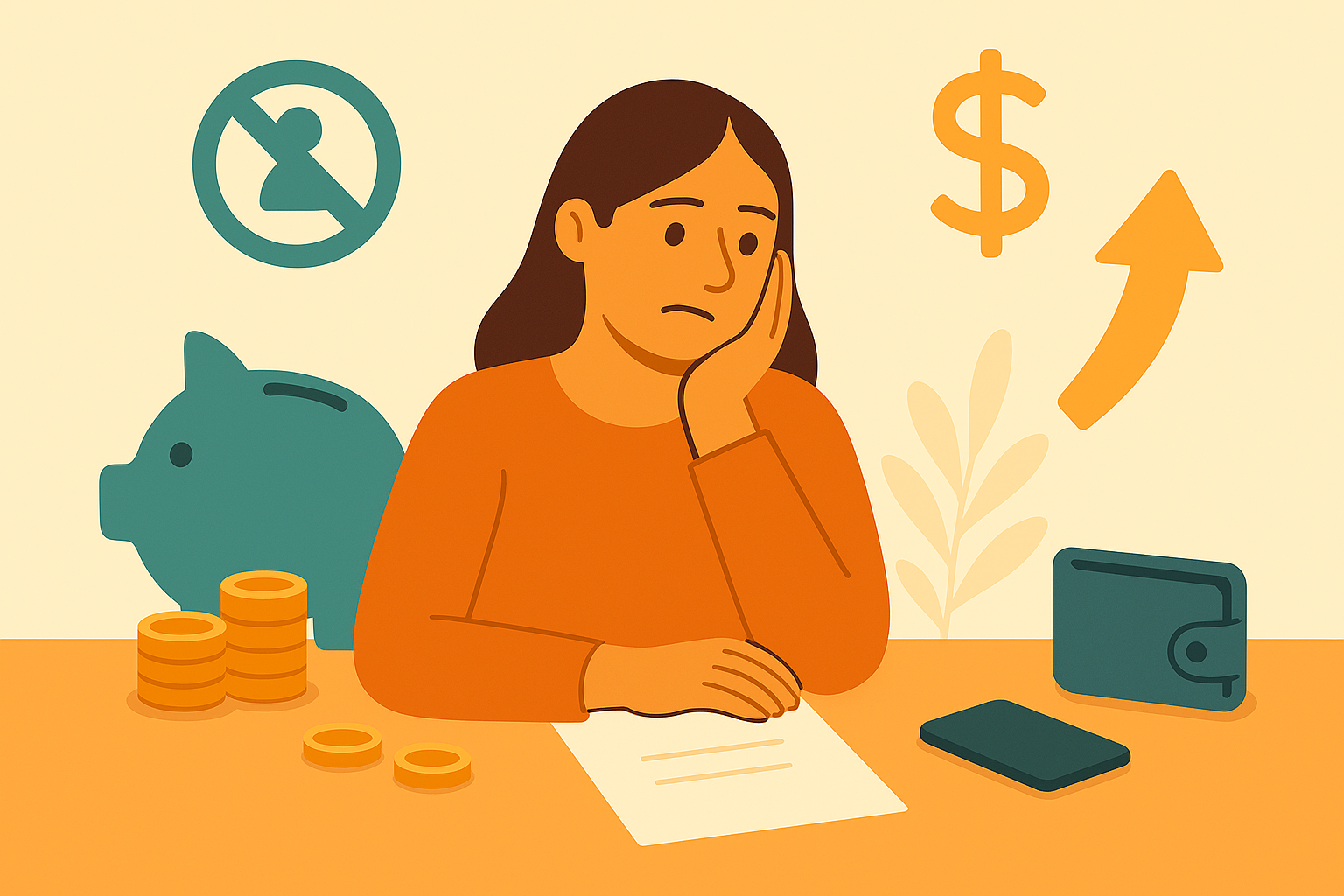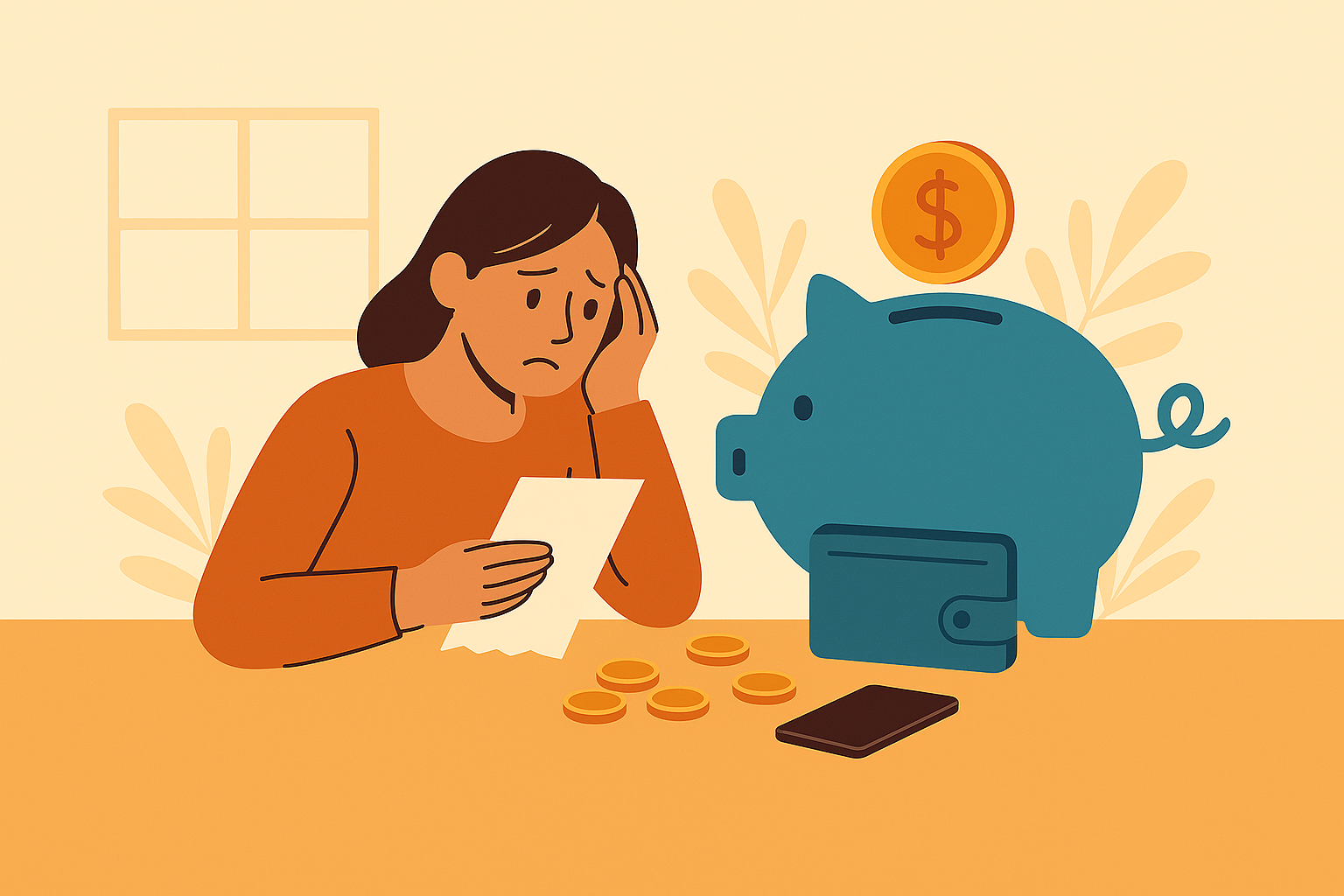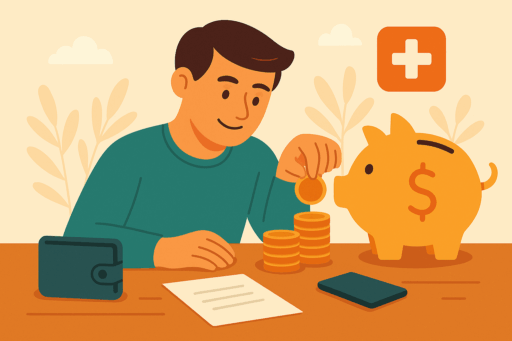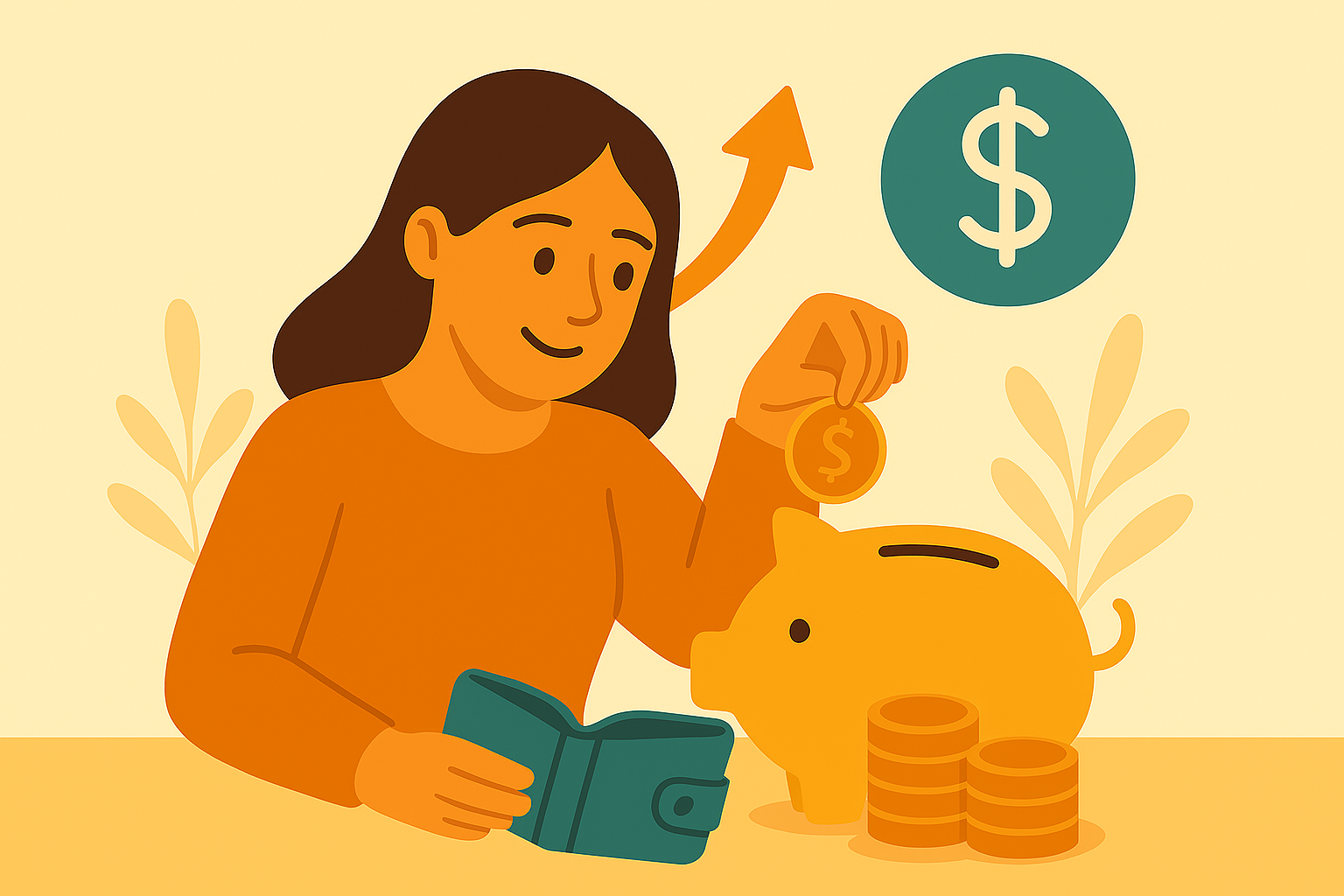If you’re desperately trying to figure out how to stop living paycheck to paycheck, you’re in the right place. Three days before payday, you’re checking your bank account every few hours like it’s going to magically refill itself. You do that mental math: “Okay, if I can make it to Thursday without buying anything, and if nothing unexpected happens, I’ll be fine.” Then your check engine light comes on. Or your kid needs money for a field trip. Or literally anything happens because life loves to kick you when you’re already down.
If you’re living paycheck to paycheck, you’re not alone. Recent studies show that nearly 60% of Americans are one unexpected expense away from financial disaster. This isn’t a “you” problem—this is a system problem, an economy problem, and an everything-keeps-getting-more-expensive problem. But here’s the truth: you can break this cycle. Not overnight, but with a real, step-by-step plan that actually works.
This guide will show you exactly how to stop living paycheck to paycheck through 10 connected steps. Each one builds on the last, and each one gets you closer to freedom. Let’s break this cycle together.
Why You’re Stuck Living Paycheck to Paycheck
You’re not living paycheck to paycheck because you’re irresponsible. Instead, you’re trapped because the math literally doesn’t work. Wages have barely budged while everything else has skyrocketed. Rent that was $800 five years ago is now $1,400. Groceries cost twice what they did two years ago. Meanwhile, your paycheck? Maybe it went up 3% if you’re lucky.
There’s also the psychological trap. When you’re constantly stressed about money, you make decisions from panic instead of strategy. Your brain is in crisis mode 24/7, which makes it nearly impossible to plan ahead. So if you’re living paycheck to paycheck right now, take a breath. This isn’t a moral failing—this is a situation you can change with the right approach.
Step 1: Assess Your Cash Flow
The first step to stop living paycheck to paycheck is the hardest: you have to know exactly where you stand financially. Most people avoid this because it’s terrifying. Opening that banking app feels like opening Pandora’s box. But you can’t fix what you won’t look at, and you definitely can’t build a budget in Step 2 if you don’t know your real numbers first.
Set aside one hour. Pull up your last two months of bank statements, all credit card statements, any loans or debts—literally every place money comes in or goes out. List all your income sources: take-home pay, side hustle income, child support, any other regular money. Write down the total. Now list every single expense. Fixed expenses like rent, car payment, insurance, phone, internet, minimum debt payments, childcare, and subscriptions. Then variable expenses: groceries, gas, utilities, dining out, entertainment, clothing, personal care, everything else.
Do the math: Income minus expenses. What’s left? If it’s negative, you’re spending more than you make, which explains everything. If it’s barely positive, one unexpected expense wipes you out. This isn’t about blame—this is about clarity. Most people are shocked when they see it all written out, and that shock is good. It’s the wake-up call you need. Whatever you discover, now you know. And knowing makes Step 2 possible.
Step 2: Create a Realistic Budget
Now that you see exactly where your money is going, it’s time to create a plan for where it should go. This is why assessment comes before budgeting—you can’t build a realistic budget on guesses. Forget the 50/30/20 rule you’ve seen everywhere. For many people learning how to stop living paycheck to paycheck, housing alone eats up 40-50% of income. The textbook rules don’t apply when you’re just trying to survive.
Start with your non-negotiables: housing, food, transportation, minimum debt payments, essential insurance, childcare. Add these up—this is your baseline survival number. Now look at what’s left over. Income minus essentials equals money for everything else. This has to cover better food, household items, clothing, medical expenses, irregular expenses, and savings. If there’s barely anything left, you’re about to discover why Step 3 comes next.
Before you can save or pay down debt, you need breathing room, and that breathing room comes from cutting the fat. Use whatever budgeting method works for you—zero-based budget, envelope system, spreadsheet, or app. The method doesn’t matter as much as having a plan for every dollar. This budget shows you what’s supposed to happen with your money, but now you need to look at where you can actually make changes.
Step 3: Cut Unnecessary Expenses
You’ve assessed your finances and created a budget. Now comes the part that creates actual change: cutting expenses. This step comes third for a reason—you can’t cut effectively without knowing what you’re spending (Step 1) or what’s essential versus optional (Step 2). Now you have both, so you can strategically attack what doesn’t need to stay.
Start with a subscription audit. Go back to those bank statements from Step 1 and highlight every recurring charge. Streaming services you forgot about, apps you’re not using, gym memberships you haven’t visited in months, that free trial that started charging you. Cancel everything you haven’t used in the last 30 days. Most people find $50-100 per month here alone.
Then calculate your convenience tax. How much are you paying for convenience? Food delivery fees and tips, convenience store purchases, buying lunch instead of packing. Track your small purchases for one week: coffee runs at $5/day equal $150/month, vending machines at $3/day equal $90/month, impulse purchases at $30-50 per trip. Multiply by four—that’s your monthly total, and it’s probably shocking.
The goal isn’t cutting everything forever. Cut aggressively for 2-3 months to break the cycle, then you can thoughtfully add things back. Every dollar you free up here goes toward building your safety net in Step 5, but first you need to make sure those freed-up dollars actually get saved instead of disappearing. That’s why Step 4 comes next.
Step 4: Automate Your Savings
You’ve found the leaks, cut expenses, and freed up money. Now the most critical step: making sure that freed-up money actually goes toward breaking the cycle instead of just evaporating. This is why automation comes immediately after cutting expenses. If you cut $100 in subscriptions but don’t redirect that $100 somewhere specific, it’ll just disappear into random spending.
Set up automatic transfers to savings the day after payday. Even if it’s just $10. Here’s why this comes now—you just freed up money in Step 3. Maybe it’s $50, maybe $100, maybe $200. That’s the money you’re going to automate. Don’t wait to see if there’s money “left over” at month-end. There never will be. Money expands to fill the space available.
Will $10 per paycheck ($240/year) make you rich? No. But it’s $240 more than you had before, and it requires zero willpower because it happens automatically. You can’t spend money you don’t see. When that money disappears automatically, you adjust your spending around what’s left. You’re not relying on discipline at the end of the month when you’re tired and stressed.
Log into your bank, find the automatic transfer option, and set it to move money from checking to savings the day after your paycheck hits. Start with the amount you freed up in Step 3. As you continue finding ways to cut expenses and potentially increase income in the coming steps, bump up your automatic transfer. All the money you’re automatically saving is building toward something specific: your escape route from the paycheck-to-paycheck cycle.
Step 5: Build an Emergency Fund
This is the step that finally breaks you free, and this is why the previous four steps had to happen first. You couldn’t build an emergency fund in Step 1 because you didn’t know where money would come from. You couldn’t do it in Step 2 because you hadn’t freed up any money yet. But now you’ve automated savings in Step 4, so money is flowing consistently. It’s time to transform that growing savings into something powerful: your emergency fund.
An emergency fund stops one unexpected expense from destroying your entire financial life. Right now, when your car needs repairs, it goes on a credit card. Then you’re paying interest on top of the emergency. That makes next month tighter, so the next emergency also goes on the card. The hole gets deeper. An emergency fund breaks that cycle completely. This is the inflection point where everything changes.
Start with $500-$1,000. Forget what you’ve heard about needing 3-6 months of expenses—that’s overwhelming when you’re living paycheck to paycheck. Thanks to automated savings from Step 4, you’re consistently building this. At $50-100 per paycheck, you’ll hit $500 in 2-5 months, and that’s achievable. This amount handles about 80% of emergencies: minor car repairs, urgent care copays, prescriptions, small appliance replacements. When you have this buffer, a $400 car repair is annoying instead of catastrophic.
You can build it faster by directing any “found money” here—tax refunds, bonuses, birthday money, rebates. Sell things you’re not using. Take on temporary extra work. Once you hit $500-$1,000, keep going. Next goal: one month of essential expenses, then three months, then six months. Keep it in a separate savings account labeled “EMERGENCY FUND – DO NOT TOUCH” and use it only for actual emergencies.
Step 6: Pay Down High-Interest Debt
Now—and only now—are you ready to aggressively attack debt. This is why debt payoff comes in Step 6, not earlier. Without the buffer you built in Step 5, any aggressive debt payoff gets derailed by the first emergency. You pay down $1,000, then your car breaks and you add $800 in new debt. You’re running in place. But now you have that buffer, so when an emergency hits, you use your emergency fund instead of credit cards. Your debt payoff progress stays intact, and this is how you actually escape instead of just surviving.
High-interest debt drains money that could be going toward building your security. A $500 emergency becomes $650 after interest and fees. First, stop adding new debt. No new credit card charges, no new loans, no more buy-now-pay-later purchases. Use your emergency fund from Step 5 for actual emergencies instead of credit cards. This will feel impossible at first because you’re used to credit cards being your backup plan, but that “backup plan” is what’s keeping you trapped.
List all your debts with the current balance, interest rate, and minimum monthly payment for each one. Then choose your payoff strategy. The avalanche method means paying minimums on everything except the highest interest rate debt—it’s mathematically optimal. The snowball method means paying minimums except the smallest balance—it’s psychologically easier with quick wins. Pick whichever you’ll actually stick with.
Remember those expenses you cut in Step 3? Some of that money goes to automated savings (Step 4) building your emergency fund (Step 5), and the rest goes to debt. Even an extra $50-100 per month makes a difference. As each debt gets paid off, you have more money to attack the next one. This is called the debt snowball effect, and it accelerates over time. As your debt decreases, you free up more money that eventually goes toward building wealth instead of paying interest. But sometimes, cutting expenses and paying down debt isn’t enough. Sometimes you need more fuel.
Step 7: Increase Your Income
This is why Step 7 focuses on increasing income—not because it’s the most important step, but because you needed Steps 1-6 first to know exactly how much extra income you need and to ensure new income doesn’t just disappear into lifestyle inflation. You’ve optimized your expenses, built a buffer, and started attacking debt. Now you can see if that’s enough or if you need to add more fuel. You need an extra $200-400 per month to transform your timeline from years to months.
Start by asking for a raise at your current job. When’s the last time you asked? Most people never ask and leave thousands on the table. Research what your position pays in your area, document your accomplishments and the value you bring, schedule a meeting with your boss, and make your case. Even a 5% raise on a $40,000 salary is $2,000 more per year—that’s $166/month. Combined with the $100 you’re saving from cut expenses, you’re suddenly banking $266/month.
If that doesn’t work or isn’t an option, consider a realistic side hustle. Not a whole business or complicated operation—just simple ways to earn extra money. Weekend gigs like driving for Uber, walking dogs, babysitting, or doing TaskRabbit jobs can bring in $200-500 per month working just 8-12 hours. If you’re good at writing, design, spreadsheets, or data entry, offer services on Upwork or Fiverr for 5-10 hours per month to generate $200-400.
Remember your automated savings from Step 4? Now you can increase that transfer. Cut $100 in expenses and earned $200 extra? Increase your automatic transfer by $300. Your emergency fund and debt payoff just accelerated dramatically. But here’s where most people mess up: they get a raise or start earning extra money, and their lifestyle immediately expands to match it. Suddenly they “need” things they never needed before. The extra income vanishes, and nothing actually changes. That’s why Step 8 is absolutely critical.
Step 8: Live Below Your Means
This step determines whether you actually break free or just get stuck at a higher income level. You’ve done the hard work—cut expenses, built savings, started paying down debt, maybe even increased your income. Things are finally getting better. And that’s exactly when most people blow it.
Here’s what happens: people get a raise, cut some expenses, and things improve. Then slowly, spending creeps back up. New car. Nicer apartment. Upgraded everything. Before they know it, they’re making more money but still living paycheck to paycheck, just at a higher income level. This is called lifestyle inflation, and it’s why people making six figures can still be broke.
The principle is simple: as your income increases, your expenses should increase slower than your income. The gap between what you make and what you spend should grow, and that growing gap is what builds wealth, creates options, and ensures you never go back to living paycheck to paycheck. When you get a raise, direct 50-75% of it straight to savings or debt payoff through that automatic transfer you set up in Step 4. Got a $200/month raise? Increase your automatic savings transfer by $150 and enjoy the other $50 guilt-free.
When you cut an expense, don’t immediately spend that freed-up money somewhere else. Redirect it by increasing your automated transfer. Paid off a $200 car payment? That doesn’t become “spending money”—it becomes savings or goes toward your next debt. See how everything connects? The automation you set up way back in Step 4 prevents lifestyle inflation later. Living below your means doesn’t mean being cheap or depriving yourself. It means being intentional about where your money goes and prioritizing security over appearance.
Step 9: Review and Adjust Monthly
You’ve built a system through Steps 1-8, and it’s working. But here’s the thing about systems: they need maintenance. Life changes, expenses change, income changes, so your system needs to evolve with you. Otherwise, you’ll wake up six months from now wondering why the progress stalled. This is why Step 9 comes near the end—you can’t reassess a system that doesn’t exist yet.
Do a monthly money check-in. Set a recurring reminder for the same day each month and spend 30-60 minutes reviewing your finances. Look at whether you stuck to your budget from Step 2, where you overspent and why, where you did better than expected. Check if your emergency fund from Step 5 is growing, if you’re making progress on debt from Step 6, if any expenses have changed, and if your automated savings from Step 4 is still moving money consistently.
Track your progress by writing down these numbers each month: emergency fund balance, total debt balance, net worth, and the amount you’re automatically saving. Watching these numbers improve month after month is incredibly motivating, and seeing progress helps you stick with the plan even when it’s hard. When life changes, your plan changes too. Got a raise? Go back to Step 8 principles and increase your automated savings to protect against lifestyle inflation. New expense? Update your budget from Step 2 to accommodate it.
Paid off a debt? Redirect that payment to your next goal from Step 6. Lost income? Cut back temporarily and protect your emergency fund from Step 5. The budget you created in Step 2 won’t be perfect forever, and that’s okay. You’ll refine it every month until it works smoothly. The key is staying engaged with your money instead of avoiding it.
Step 10: Make Bigger Lifestyle Changes
This step comes last for a very specific reason: you don’t know if you need major lifestyle changes until you’ve tried everything else. Many people learning how to stop living paycheck to paycheck succeed through Steps 1-9 without selling their car, moving to a cheaper apartment, or relocating to a different city. But some people can’t. Sometimes the gap between income and expenses is just too wide.
Consider major lifestyle changes if you’ve been following Steps 1-9 for 6+ months and still can’t save consistently, if your housing costs more than 40% of your income even after cutting everything else, if your car payment is more than 15% of your income, if you’re in a high cost-of-living area making low wages with no path to higher income, or if your debt is so overwhelming that minimum payments alone consume most of your income.
For housing, you might downsize to save $300-500 per month on rent, get a roommate to cut costs by 30-50%, move to a cheaper area where expenses drop more than income, or temporarily move in with family to build savings without rent hanging over you. For transportation, consider selling your car to get something cheaper with no payment, downgrading to one car if you’re a two-car household, moving closer to work to eliminate commute costs, or using public transportation if it’s available.
For your career, you might change industries for better pay, get strategic training or education to increase earning potential, relocate for better opportunities, or change companies for a 20-30% raise doing the same work. These changes are hard. They feel like failure or going backwards. They’re not—they’re strategic moves to break free. Living with roommates in your 30s isn’t failure, it’s choosing financial security over pride. Selling your nice car for a beater isn’t going backwards, it’s eliminating a payment that’s holding you hostage.
How These Steps Work Together
Let’s see how this all connects because the sequence really matters. Step 1 shows you the problem clearly. Step 2 creates a plan to address it. Step 3 frees up money by cutting waste. Step 4 captures that money through automation. Step 5 uses that automated money to build your safety net. Step 6 attacks debt now that you have protection. Step 7 accelerates everything with extra income. Step 8 protects your progress from lifestyle inflation. Step 9 maintains the system through regular check-ins. Step 10 makes bigger changes if needed.
Each step is essential, and each step enables the next one. Try to build an emergency fund without automation? You’ll fail because the money disappears. Try to pay down debt without an emergency fund? The next emergency creates new debt and you’re on a treadmill. Try to increase income without fixing spending? Lifestyle inflation eats the extra money and nothing changes. The sequence matters, the connections matter, and this isn’t just a list of tips—it’s a complete system for how to stop living paycheck to paycheck permanently.
What to Expect
Here’s what nobody tells you about following these steps: it’s not linear. Some months you’ll crush it, stick to your budget, save money, and make real progress. You’ll feel like you’ve finally figured it out. Other months, something will go wrong. An unexpected expense will hit, you’ll slip up on the budget, and you’ll feel like you’re back at square one. That’s normal. That’s expected. That’s part of the process.
The difference between people who break free and people who stay trapped isn’t that the first group never has setbacks. It’s that they keep going anyway. They go back to Step 1 and reassess. They adjust their budget in Step 2. They tighten up on cuts in Step 3. They keep their automation running in Step 4. They rebuild their emergency fund in Step 5 if they had to use it. They stay in the system even when it’s hard.
If you’ve been living paycheck to paycheck for years, breaking free will take time. Probably 6-18 months to feel significantly better, maybe 2-3 years to feel completely secure. That feels like forever when you’re struggling right now, but those 2-3 years are going to pass anyway. You can spend them staying trapped, or you can spend them building your way out. You’ll know you’ve broken free when an unexpected $200 expense is annoying but not panic-inducing, when you don’t check your bank account before buying groceries, when you make it to payday with money left in checking, when you can handle your car breaking down without spiraling into debt, and when you don’t have a physical stress response when opening your banking app.
Start Today
Don’t try to do all 10 steps at once. Start with three actions this week: list every income source and expense from the last 30 days (Step 1), create your budget with those numbers (Step 2), and cancel one subscription or recurring expense today (Step 3). Next week, set up automation (Step 4), calculate your emergency fund target (Step 5), and list all your debts (Step 6). Small steps, consistent progress—that’s how to stop living paycheck to paycheck. You don’t need perfection. You just need persistence.
Breaking free from living paycheck to paycheck is possible. These 10 steps work because they’ve worked for thousands of people in your exact situation. The steps are connected, each one enables the next, so follow them in order and trust the system. That version of you who isn’t constantly stressed about money, who has breathing room and options, who can handle life’s unexpected expenses without panic? They’re waiting on the other side of the work you’re about to do.
Let’s get you there.
What’s your biggest challenge with living paycheck to paycheck? Which step feels most difficult? Drop a comment below—you’re not alone in this.






